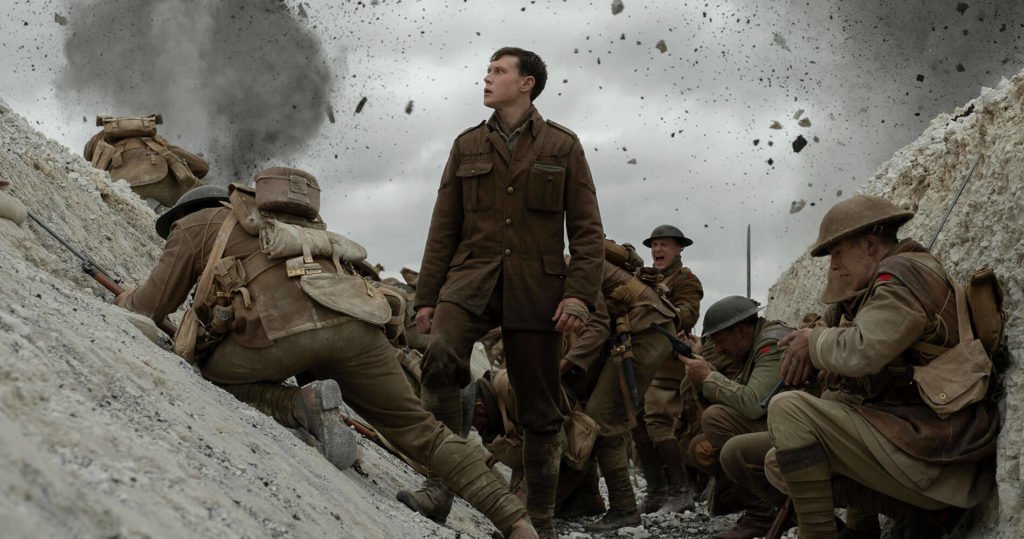
The word “marathon” originates from the Greek legend of Pheidippides, the tale of a messenger who ran from the town of Marathon, Greece, to Athens to deliver a message of victory. As he arrived in Athens, he was so exhausted that he collapsed and died after speaking his last words: “Joy to you, we’ve won.”
The film “1917” by Sam Mendes follows two British soldiers in World War I. Their mission is simply to deliver a message from point A to point B — if they fail, 1,600 lives will be lost, including the brother of one of the messengers. It’s a marathon in its own right, physically and emotionally.

Our protagonists aren’t your typical weathered, 40-year-old Hollywood stars with grizzled chins and graying hair. The film is accurate to the truth: wars are fought by the young, and in this case, Lance Corporals Will Schofield and Tom Blake (played by George MacKay and Dean-Charles Chapman) are both short on years but long on experience.
The first thing one might notice from the film is how the entire thing (with perhaps one exception) is made to look like a continuous shot. In filmmaking circles, this is known as a “oner,” and some modern examples of this include “Birdman” and a couple of scenes from “Children of Men.” Steven Spielberg uses the technique in a way that draws less attention to itself. A classic example of a oner is Alfred Hitchcock’s 1948 film, “Rope.” It doesn’t mean the movie was actually filmed in one take, but it’s just stitched together to look that way.
Sometimes the oner is used as a gimmick, a technique aimed at glorifying the abilities of the filmmakers. In contrast, “1917” uses the oner technique in the service of its story; as the two young soldiers fight obstacle after obstacle, the viewer almost feels exhausted right along with them. At times, war can feel like a nonstop barrage of tragedy, and “1917” gives us a small insight into that, especially in the context of one of the most harrowing wars of all time.
As far as world wars go, World War I is often overshadowed by the incredible stories of World War II. It is refreshing to see a World War I film, and in the context of this linear marathon, it was interesting to see our protagonists move from one incredible set piece to the next. Each location had some facet unique to the Great War that may not be familiar to anyone watching the majority of war movies made in the last couple of decades. Trench warfare, prolific disease, the use of horses, older equipment, and vehicles — it gives us an insight into the brutality of the first world war.

There is a constant feeling of tension throughout the film. Even the quiet moments — when we see trees blossoming and the French breeze rolls over the gentle hillsides — are saturated with an underlying feeling of unease. Experiencing this for two straight hours is tiring, and that is exactly what makes good war films so important to watch. It’s a movie based on stories told by the director’s grandfather, so strictly speaking one would call it fiction — but it serves an important purpose. History textbooks and fiction have two different functions when it comes to telling stories of the past. One tells us what happened, the other tells us what it felt like. Both fall indescribably short of the real thing, but they are all we have. “1917” explores many corners of the Great War and violence, but its most effective theme was the sheer emotional and physical toll it took on those who fought it — the marathon of war.

Luke is the author of two war poetry books, The Gun and the Scythe and A Moment of Violence, and a post-apocalyptic novel, The First Marauder. He grew up in Pakistan and Thailand as the son of aid workers. Later, he served as an Army Ranger and deployed to Afghanistan on four combat deployments. Now he owns and operates Four Hawk Media, a social media-focused marketing company.
BRCC and Bad Moon Print Press team up for an exclusive, limited-edition T-shirt design!
BRCC partners with Team Room Design for an exclusive T-shirt release!
Thirty Seconds Out has partnered with BRCC for an exclusive shirt design invoking the God of Winter.
Lucas O'Hara of Grizzly Forge has teamed up with BRCC for a badass, exclusive Shirt Club T-shirt design featuring his most popular knife and tiomahawk.
Coffee or Die sits down with one of the graphic designers behind Black Rifle Coffee's signature look and vibe.
Biden will award the Medal of Honor to a Vietnam War Army helicopter pilot who risked his life to save a reconnaissance team from almost certain death.
Ever wonder how much Jack Mandaville would f*ck sh*t up if he went back in time? The American Revolution didn't even see him coming.
A nearly 200-year-old West Point time capsule that at first appeared to yield little more than dust contains hidden treasure, the US Military Academy said.












